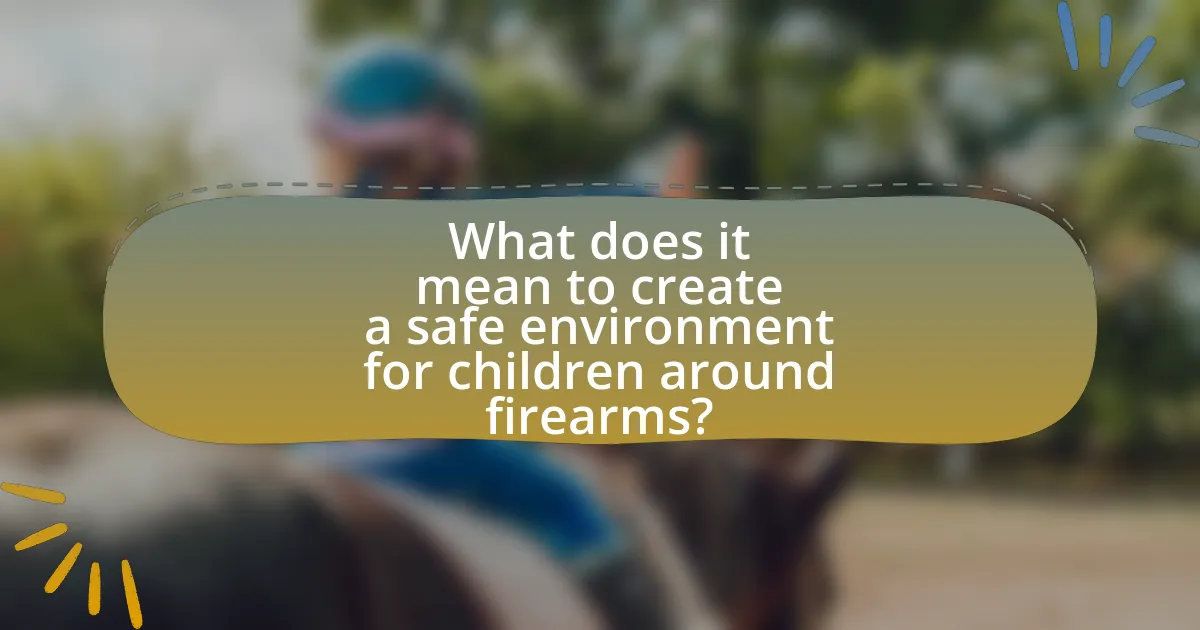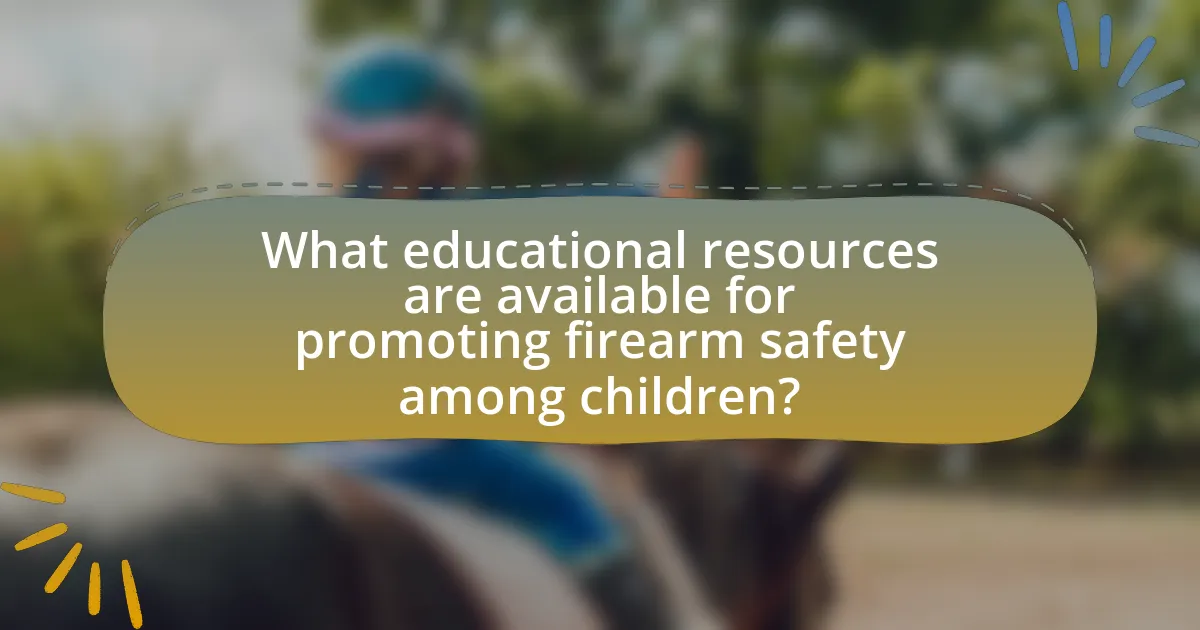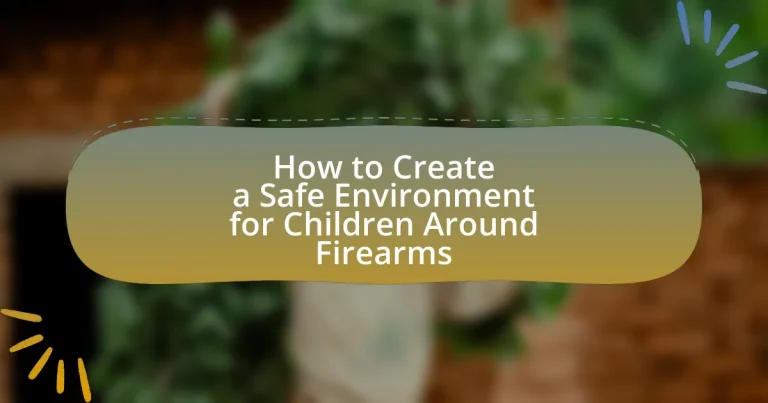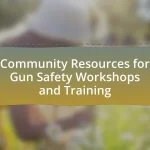Creating a safe environment for children around firearms involves implementing secure storage practices and educating children about firearm safety. Key measures include locking firearms in cabinets or safes, using gun locks, and storing ammunition separately. Statistics reveal that approximately 1,300 children die annually from unintentional firearm-related incidents in the United States, underscoring the importance of these safety measures. Parents and guardians play a crucial role in reinforcing firearm safety through open discussions and modeling responsible behavior, while educational programs and community resources further promote awareness and safe practices.

What does it mean to create a safe environment for children around firearms?
Creating a safe environment for children around firearms means implementing measures that prevent access to guns and educate children about firearm safety. This includes securely storing firearms in locked cabinets or safes, using gun locks, and ensuring that ammunition is stored separately from firearms. According to the Centers for Disease Control and Prevention, proper storage can significantly reduce the risk of unintentional shootings and suicides among children. Additionally, educating children about the dangers of firearms and encouraging open discussions about safety can further enhance their understanding and reduce risks.
Why is it important to ensure firearm safety for children?
Ensuring firearm safety for children is crucial to prevent accidental injuries and fatalities. Statistics indicate that in the United States, approximately 1,300 children die each year from unintentional firearm-related incidents, highlighting the urgent need for safety measures. Implementing firearm safety education and secure storage practices significantly reduces the risk of children accessing firearms, thereby protecting their lives and promoting a safer environment.
What statistics highlight the risks of firearms around children?
In the United States, approximately 1,300 children aged 0 to 17 are killed by firearms each year, highlighting the significant risks firearms pose around children. Additionally, a study published in the journal “Pediatrics” found that nearly 1 in 3 households with children have at least one firearm, and among those households, 43% of the firearms are stored unlocked. This unsafe storage increases the likelihood of accidental shootings and suicides among children. Furthermore, the Centers for Disease Control and Prevention (CDC) reports that firearms are the second leading cause of death for children aged 1 to 17, underscoring the urgent need for safe firearm practices in homes with children.
How can firearm accidents impact families and communities?
Firearm accidents can have devastating effects on families and communities by causing loss of life, emotional trauma, and financial strain. Families often experience grief and psychological distress following an accident, which can lead to long-term mental health issues such as depression and anxiety. Communities may face increased fear and a sense of insecurity, leading to a breakdown in social cohesion. According to the Centers for Disease Control and Prevention, in 2020, there were over 45,000 gun-related deaths in the United States, many of which were accidental, highlighting the widespread impact of such incidents. Additionally, the economic burden of firearm accidents can be significant, with costs related to medical care, legal proceedings, and loss of productivity.
What are the key principles of firearm safety for children?
The key principles of firearm safety for children include treating every firearm as if it is loaded, keeping firearms stored securely and out of reach, and ensuring children understand the importance of not touching firearms without adult supervision. Treating every firearm as if it is loaded instills a mindset of caution, reducing the likelihood of accidental discharges. Secure storage, such as using gun safes or locked cabinets, prevents unauthorized access, which is crucial given that studies show that a significant percentage of unintentional shootings involve children accessing improperly stored firearms. Educating children about the dangers of firearms and establishing clear rules about handling them fosters a culture of safety and responsibility.
What are the fundamental rules of firearm safety?
The fundamental rules of firearm safety are: always treat every firearm as if it is loaded, never point a firearm at anything you do not intend to shoot, keep your finger off the trigger until you are ready to shoot, and be sure of your target and what is beyond it. These rules are essential for preventing accidental discharges and ensuring responsible firearm handling. According to the National Shooting Sports Foundation, adherence to these safety rules significantly reduces the risk of firearm-related accidents.
How can these rules be effectively communicated to children?
Rules can be effectively communicated to children by using clear, simple language and engaging teaching methods. For instance, using storytelling or role-playing scenarios helps children understand the importance of firearm safety rules in relatable contexts. Research indicates that children retain information better when it is presented in interactive formats, such as games or hands-on activities, which can reinforce the seriousness of the rules while keeping them engaged. Additionally, consistent reinforcement through regular discussions and reminders about these rules can help solidify their understanding and compliance.
What role do parents and guardians play in firearm safety?
Parents and guardians play a crucial role in firearm safety by ensuring that firearms are stored securely and educating children about the dangers associated with guns. They are responsible for implementing safe storage practices, such as using gun safes or lockboxes, which can reduce the risk of unauthorized access. According to the American Academy of Pediatrics, approximately 1.7 million children live in homes with loaded and unlocked firearms, highlighting the need for parental vigilance. Additionally, parents and guardians should engage in open conversations with their children about firearm safety, teaching them to recognize firearms and understand the importance of reporting any gun-related incidents to an adult. This proactive approach significantly contributes to preventing accidents and promoting a culture of safety around firearms.
How can parents model safe behavior around firearms?
Parents can model safe behavior around firearms by consistently demonstrating responsible handling and storage practices. This includes keeping firearms locked in a safe or secured location, ensuring that children do not have access to them, and discussing the importance of gun safety openly. Research indicates that homes with locked firearms significantly reduce the risk of accidental shootings among children, as highlighted by the American Academy of Pediatrics, which emphasizes that safe storage can prevent unauthorized access. Additionally, parents should engage in conversations about the dangers of firearms, teaching children to recognize and report any firearms they encounter outside the home.
What conversations should parents have with their children about firearms?
Parents should have open and honest conversations with their children about firearms, focusing on safety, responsibility, and the potential dangers associated with guns. These discussions should include explaining what firearms are, the importance of treating all guns as if they are loaded, and the necessity of not touching a gun without adult supervision.
Additionally, parents should educate their children on the concept of “stop, don’t touch, run away, and tell an adult” if they encounter a firearm. Research indicates that children who receive proper education about firearms are less likely to engage in unsafe behaviors (American Academy of Pediatrics). By fostering an environment of trust and communication, parents can help their children understand the serious nature of firearms and promote safe practices.

How can firearms be securely stored to protect children?
Firearms can be securely stored to protect children by using locked gun safes or cabinets that are inaccessible to minors. These storage solutions should be designed to prevent unauthorized access, with many models featuring biometric locks, combination locks, or key locks. According to the National Safety Council, storing firearms unloaded and locked, with ammunition stored separately, significantly reduces the risk of accidental shootings among children. Additionally, educating family members about safe firearm handling and storage practices further enhances safety.
What are the best practices for firearm storage?
The best practices for firearm storage include using a secure gun safe, storing firearms unloaded, and keeping ammunition separate from the firearms. A gun safe provides a locked environment that prevents unauthorized access, particularly by children. Storing firearms unloaded reduces the risk of accidental discharge, while separating ammunition ensures that firearms cannot be easily loaded by unauthorized users. According to the National Safety Council, proper storage can significantly reduce the risk of firearm-related accidents in homes with children.
What types of gun safes are available and how do they work?
There are several types of gun safes available, including biometric safes, electronic keypad safes, mechanical lock safes, and portable gun safes. Biometric safes use fingerprint recognition technology to grant access, ensuring that only authorized users can open the safe. Electronic keypad safes require a numerical code to unlock, providing quick access while maintaining security. Mechanical lock safes utilize a combination dial or key, offering a traditional method of securing firearms. Portable gun safes are designed for travel and can be secured with a cable lock or combination lock, allowing for safe storage in various locations. Each type of gun safe is designed to prevent unauthorized access, thereby creating a safer environment for children around firearms.
How can trigger locks enhance firearm safety?
Trigger locks enhance firearm safety by preventing unauthorized access to the firearm, particularly by children. These devices secure the trigger mechanism, making it impossible to fire the weapon without first removing the lock. According to the National Safety Council, using a trigger lock can significantly reduce the risk of accidental discharges, especially in homes with children. By ensuring that firearms are not easily operable, trigger locks serve as a critical layer of protection in creating a safe environment around firearms.
What should be considered when choosing a storage location for firearms?
When choosing a storage location for firearms, prioritize security, accessibility, and environmental conditions. Secure locations should be locked and out of reach of children, such as gun safes or locked cabinets, to prevent unauthorized access. Accessibility is crucial for responsible adults to retrieve firearms quickly in emergencies, while environmental conditions should protect firearms from moisture and temperature extremes, which can affect their functionality. According to the National Shooting Sports Foundation, 73% of unintentional firearm deaths among children occur in homes where firearms are stored improperly, highlighting the importance of safe storage practices.
How does accessibility affect firearm safety for children?
Accessibility significantly increases the risk of firearm-related incidents among children. When firearms are easily accessible, children may find and handle them without adult supervision, leading to accidental discharges or misuse. According to the American Academy of Pediatrics, approximately 1,300 children die from gun-related injuries each year in the United States, with many of these incidents occurring in homes where firearms are stored improperly. Proper storage practices, such as using gun safes or locking devices, can reduce the likelihood of children accessing firearms and subsequently enhance overall firearm safety.
What environmental factors should be taken into account for storage?
Environmental factors that should be taken into account for storage include temperature, humidity, light exposure, and security. Temperature extremes can affect the integrity of firearms and ammunition, potentially leading to malfunctions. Humidity levels above 50% can promote rust and corrosion, damaging metal components. Light exposure, particularly ultraviolet light, can degrade materials over time, affecting both the firearm and its storage case. Security measures, such as locks and safes, are essential to prevent unauthorized access, especially by children. These factors collectively ensure that firearms are stored safely and remain in optimal condition, reducing risks associated with improper storage.

What educational resources are available for promoting firearm safety among children?
Educational resources available for promoting firearm safety among children include the Eddie Eagle GunSafe Program, the National Rifle Association’s (NRA) “Refuse to Be a Victim” program, and various local and state firearm safety courses designed for youth. The Eddie Eagle program, developed by the NRA, teaches children a simple message: “Stop, Don’t Touch, Run Away, Tell a Grown-Up,” which is reinforced through engaging materials like videos and activity books. Research indicates that programs like these effectively reduce the risk of firearm accidents among children by instilling safe behaviors and awareness. Additionally, organizations such as the American Academy of Pediatrics recommend educational initiatives that involve parents and guardians in discussions about firearm safety, further emphasizing the importance of a comprehensive approach to safety education.
What programs and materials can help teach children about firearm safety?
Programs and materials that can help teach children about firearm safety include the Eddie Eagle GunSafe Program, the National Rifle Association’s (NRA) “Refuse to Be a Victim” program, and various educational resources from organizations like the American Academy of Pediatrics. The Eddie Eagle program, developed by the NRA, uses a cartoon character to teach children the four key rules of firearm safety: stop, don’t touch, run away, and tell an adult. Research indicates that programs like these effectively reduce the risk of firearm accidents among children by instilling safe behaviors. Additionally, the American Academy of Pediatrics provides guidelines and resources for parents to discuss firearm safety with their children, emphasizing the importance of open communication and education.
How can schools incorporate firearm safety education into their curriculum?
Schools can incorporate firearm safety education into their curriculum by integrating structured programs that teach students about the safe handling, storage, and risks associated with firearms. These programs can include age-appropriate lessons, interactive workshops, and partnerships with local law enforcement or firearm safety organizations. For instance, the National Rifle Association (NRA) offers the Eddie Eagle GunSafe Program, which provides resources for educators to teach children about gun safety in a non-threatening manner. Research indicates that early education on firearm safety can significantly reduce accidental shootings among children, highlighting the importance of such initiatives in creating a safer environment.
What role do community organizations play in firearm safety education?
Community organizations play a crucial role in firearm safety education by providing resources, training, and outreach programs aimed at promoting safe firearm practices. These organizations often collaborate with local law enforcement, schools, and health agencies to deliver educational workshops and seminars that inform community members about the importance of safe storage, handling, and usage of firearms. For instance, studies have shown that community-based interventions can significantly reduce firearm-related accidents and injuries, particularly among children, by fostering awareness and responsible behavior.
How can parents reinforce firearm safety education at home?
Parents can reinforce firearm safety education at home by establishing clear rules about firearm access and usage. They should engage in open discussions about the dangers of firearms, emphasizing the importance of treating every gun as if it is loaded. Parents can also demonstrate safe handling practices, such as keeping firearms secured in a locked safe and ensuring that children understand the concept of “stop, don’t touch, leave the area, and tell an adult” if they encounter a firearm. Research indicates that consistent education and modeling of safe behaviors significantly reduce the risk of firearm-related accidents among children.
What activities can parents engage in with children to promote safety awareness?
Parents can engage in role-playing scenarios with children to promote safety awareness regarding firearms. This activity allows children to practice responding to various situations involving firearms, such as what to do if they encounter a gun. Research indicates that children who participate in interactive safety training are more likely to remember safety protocols and apply them in real-life situations. Additionally, discussing the importance of firearm safety and establishing clear rules about gun access can reinforce the lessons learned during these activities.
How can discussions about firearms be made age-appropriate?
Discussions about firearms can be made age-appropriate by tailoring the language and content to the developmental level of the audience. For younger children, focus on basic concepts such as safety and the importance of not touching firearms without adult supervision. Use simple, clear language and relatable scenarios to explain why firearms can be dangerous. For older children and teenagers, discussions can include more detailed information about the mechanics of firearms, responsible ownership, and the legal implications of firearm use. Incorporating statistics, such as the fact that the Centers for Disease Control and Prevention reported over 39,000 firearm-related deaths in the U.S. in 2019, can provide context for the seriousness of the topic. Engaging children in conversations about their feelings and perceptions regarding firearms can also help make the discussion more relevant and age-appropriate.
What are some practical tips for maintaining a safe environment around firearms?
To maintain a safe environment around firearms, secure all firearms in a locked safe or cabinet when not in use. This prevents unauthorized access, particularly by children, which is crucial given that studies show that approximately 1.7 million children live in homes with loaded and unlocked firearms. Additionally, always store ammunition separately from firearms to reduce the risk of accidental discharge. Regularly educate all household members about firearm safety, including the importance of treating every firearm as if it is loaded. Implementing these practices significantly decreases the likelihood of firearm-related accidents in homes with children.
How can regular safety checks be implemented in the home?
Regular safety checks can be implemented in the home by establishing a routine schedule for inspecting firearms and their storage conditions. This involves checking that firearms are securely locked in a safe or cabinet, ensuring that ammunition is stored separately, and verifying that safety mechanisms are functioning properly. According to the American Academy of Pediatrics, regular inspections can significantly reduce the risk of accidental discharges and unauthorized access, thereby enhancing child safety around firearms.
What steps should be taken if a child encounters a firearm?
If a child encounters a firearm, they should immediately stop what they are doing and not touch the weapon. The child must then leave the area where the firearm is located and find a trusted adult to inform them about the situation. This response is crucial because handling firearms can lead to accidental discharges, which are a significant cause of injury and death among children. According to the Centers for Disease Control and Prevention, unintentional firearm injuries are among the leading causes of death for children aged 1 to 17 in the United States. Therefore, teaching children these steps can significantly enhance their safety around firearms.


